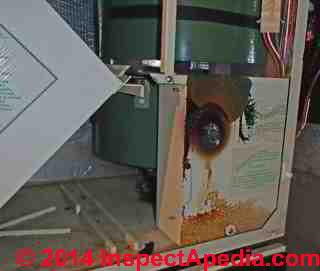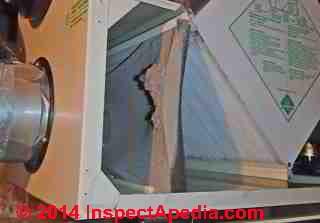 Heat Recovery Ventilator Fire Report
Heat Recovery Ventilator Fire Report
- POST a QUESTION or COMMENT about HRV fires, hazards, & recalls
Heat recovery ventilator field report of a fire:
This article describes a field observation of a fire-damaged heat recovery ventilator unit found by Minnesota home inspector Roger Hankey.
The inspection suggests that the root cause of the fire at this HRV was the collapse of an air filter that was drawn into the fan assembly. Remarkably the home owner's report that the heat recovery ventilator was in working order suggests that the hazard and equipment failure had remained un-discovered for a long time.
InspectAPedia tolerates no conflicts of interest. We have no relationship with advertisers, products, or services discussed at this website.
- Daniel Friedman, Publisher/Editor/Author - See WHO ARE WE?
Field report of Heat Recovery Ventilator HRV Fire / Overheat Damage
Mr. Hankey notes: The home seller's disclosure indicated the HRV was in working condition. Our field observation found that this was not the case. [Click to enlarge any image]
This was a VanEE heat recovery ventilation unit built & installed circa 1987. That dates this device as having been manufactured before the units made in 1991-2001 and cited in
the HEAT RECOVERY VENTILATOR RECALL.
There you will read that Venmar made heat recovery ventilator systems that were sold under multiple brand names besides VanEE, including Venmar, Broan - Guardian, Conformax, Nutone, Bryant Carrier - Standard, Carrier, Bryant - Payne Day & Night, Heil, Sears, York, Rudd Protech - Weatherking, and Rheem. Note that since not every HRV sold by those companies is subject to the recall, you'll want to check the article cited above.
Notice clogged collapsed intake filter (photo above right). I attribute the motor burn out to the clogged filter.
See details at DIRTY AIR FILTER PROBLEMS
In any event, the inspection report recommendation was for correction by a qualified HVAC firm.
I unplugged the power cord even though no heat was present at time of inspection.
Watch out: If you have one of the Venmar Heat Recovery Ventilator models listed
at HEAT RECOVERY VENTILATOR RECALL., turn off the equipment and unplug it.
Watch out also: for a collapsing or collapsed or improperly-sized or supported air filter in any heat recovery ventilator or other air handling equipment. An improperly-installed or designed air filter that collapses and becomes drawn into the blower assembly can cause the motor to overheat and may cause a building fire. These hazards are present in any HVAC system that incorporates a blower fan and air filter in a position where a failed or damaged filter or other object could be drawn into moving parts such as the fan assembly.
Roger Hankey is principal of Hankey and Brown Inspections, Winter Park, CO. Mr. Hankey is a past chairman of the ASHI Standards Committee and served in other ASHI chapter and national leadership roles. Mr. Hankey is a National Radon Proficiency Program certified measurement professional and a Level II infrared thermographer. Contact Roger Hankey at: 970-393-6604 - rogerhankey47@gmail.com . Website: www.HankeyandBrown.com Mr. Hankey is a frequent contributor to InspectAPedia.com.
...
Continue reading at VENTILATION in BUILDINGS or select a topic from the closely-related articles below, or see the complete ARTICLE INDEX.
Or see
SAFETY RECALLS CHIMNEYS VENTS HEATERS
Suggested citation for this web page
HEAT RECOVERY VENTILATOR FIRE at InspectApedia.com - online encyclopedia of building & environmental inspection, testing, diagnosis, repair, & problem prevention advice.
Or see this
INDEX to RELATED ARTICLES: ARTICLE INDEX to BUILDING VENTILATION
Or use the SEARCH BOX found below to Ask a Question or Search InspectApedia
Ask a Question or Search InspectApedia
Try the search box just below, or if you prefer, post a question or comment in the Comments box below and we will respond promptly.
Search the InspectApedia website
Note: appearance of your Comment below may be delayed: if your comment contains an image, photograph, web link, or text that looks to the software as if it might be a web link, your posting will appear after it has been approved by a moderator. Apologies for the delay.
Only one image can be added per comment but you can post as many comments, and therefore images, as you like.
You will not receive a notification when a response to your question has been posted.
Please bookmark this page to make it easy for you to check back for our response.
IF above you see "Comment Form is loading comments..." then COMMENT BOX - countable.ca / bawkbox.com IS NOT WORKING.
In any case you are welcome to send an email directly to us at InspectApedia.com at editor@inspectApedia.com
We'll reply to you directly. Please help us help you by noting, in your email, the URL of the InspectApedia page where you wanted to comment.
Citations & References
In addition to any citations in the article above, a full list is available on request.
- Roger Hankey is principal of Hankey and Brown Inspections, Winter Park, CO. Mr. Hankey is a past chairman of the ASHI Standards Committee and served in other ASHI chapter and national leadership roles. Mr. Hankey is a National Radon Proficiency Program certified measurement professional and a Level II infrared thermographer. Contact Roger Hankey at: 970-393-6604 - rogerhankey47@gmail.com . Website: www.HankeyandBrown.com Mr. Hankey is a frequent contributor to InspectAPedia.com.
- ASHRAE, Handbook, A. S. H. R. A. E. "Fundamentals." American Society of Heating, Refrigerating and Air Conditioning Engineers, Atlanta 111 (2001).
- ASHRAE, Handbook, A. S. H. R. A. E. "HVAC systems and equipment." American Society of Heating, Refrigerating, and Air Conditioning Engineers, Atlanta, GA (1996).
- DeGregoria, Anthony J., and Thomas J. Kaminski. "Integrated heat recovery ventilator HEPA filter using a HEPA filter material regenerative heat exchanger." U.S. Patent 6,289,974, issued September 18, 2001.
- Kovesi, T., C. Zaloum, C. Stocco, D. Fugler, R. E. Dales, A. Ni, N. Barrowman, N. L. Gilbert, and J. D. Miller. "Heat recovery ventilators prevent respiratory disorders in Inuit children." Indoor Air 19, no. 6 (2009): 489-499.
- Linden, Paul F. "The fluid mechanics of natural ventilation." Annual review of fluid mechanics 31, no. 1 (1999): 201-238.
- Markowski, Walter J., and Albert J. Marron. "Total heat energy exchangers." U.S. Patent 4,093,435, issued June 6, 1978.
- Mentuch, Stephen. "Heat recovery ventilator." U.S. Patent 4,742,957, issued May 10, 1988.
- Olmstead, Richard W., and Douglas B. Wicks. "Heat recovery system." U.S. Patent 5,002,118, issued March 26, 1991.
- Warner, Jill A., Jeanette M. Frederick, Trevor N. Bryant, Christine Weich, Gary J. Raw, Colin Hunter, Frank R. Stephend, Donald A. McIntyre, and John O. Warner. "Mechanical ventilation and high-efficiency vacuum cleaning: A combined strategy of mite and mite allergen reduction in the control of mite-sensitive asthma." Journal of allergy and clinical immunology 105, no. 1 (2000): 75-82.
- VENTILATION for ENERGY-EFFICIENT BUILDINGS [PDF] Purpose of ventilation, ventilateion strategies, etc.
- Weather-Resistive Barriers, how to select and install housewrap and other types of weather resistive barriers, U.S. DOE
- Whole House Ventilation Systems, U.S. Department of Energy
- Whole-House Balanced Ventilation Systems, U.S. Department of Energy
- Whole-House Exhaust Ventilation Systems, U.S. Department of Energy
- Whole-House Supply Ventilation Systems, U.S. Department of Energy
- Air-to-Air Heat Exchangers for Healthier Energy-Efficient Homes, Kenenth Hellevang, PH.D., P.E., Extension Engineer, and Carl Pederson, Energy Educator, North Dakota State University, AE-1393, NDSU Extension Service, North Dakota State University, Fargo ND 58108, March 2009. Web search 02/04/2011, original source: http://www.ag.ndsu.edu/pubs/ageng/structu/ae1393.pdf, reproduced for non-commercial use, with permission.
- DUST, HVAC CONTAMINATION STUDY An Investigation of Indoor Dust Debris Blamed on a Heating/Cooling System Reveals Carpet Dust
- National Fuel Gas Code (Z223.1) $16.00 and National Fuel Gas Code Handbook (Z223.2) $47.00 American Gas Association (A.G.A.), 1515 Wilson Boulevard, Arlington, VA 22209 also available from National Fire Protection Association, Batterymarch Park, Quincy, MA 02269. Fundamentals of Gas Appliance Venting and Ventilation, 1985, American Gas Association Laboratories, Engineering Services Department. American Gas Association, 1515 Wilson Boulevard, Arlington, VA 22209. Catalog #XHO585. Reprinted 1989.
- BASEMENT MOISTURE CONTROL [PDF] U.S. Department of Energy
- Building Pathology, Deterioration, Diagnostics, and Intervention, Samuel Y. Harris, P.E., AIA, Esq., ISBN 0-471-33172-4, John Wiley & Sons, 2001 [General building science-DF] ISBN-10: 0471331724 ISBN-13: 978-0471331728
- Building Pathology: Principles and Practice, David Watt, Wiley-Blackwell; 2 edition (March 7, 2008) ISBN-10: 1405161035 ISBN-13: 978-1405161039
- CRAWL SPACE MOISTURE CONTROL [PDF] U.S. Department of Energy
- Energy Recover Ventilation Systems for buildings, U.S. Department of Energy
- Energy Savings Methods: Whole House Systems Approach, U.S. Department of Energy
- MOISTURE CONTROL in WALLS [PDF] U.S. Department of Energy
- Natural Ventilation for buildings, U.S. Department of Energy
- R-Value of Wood, U.S. Department of Energy
- Spot Ventilation for houses, U.S. Department of Energy
- Slab on Grade Foundation Moisture and Air Leakage, U.S. Department of Energy
- Our recommended books about building & mechanical systems design, inspection, problem diagnosis, and repair, and about indoor environment and IAQ testing, diagnosis, and cleanup are at the InspectAPedia Bookstore. Also see our Book Reviews - InspectAPedia.
- In addition to citations & references found in this article, see the research citations given at the end of the related articles found at our suggested
CONTINUE READING or RECOMMENDED ARTICLES.
- Carson, Dunlop & Associates Ltd., 120 Carlton Street Suite 407, Toronto ON M5A 4K2. Tel: (416) 964-9415 1-800-268-7070 Email: info@carsondunlop.com. Alan Carson is a past president of ASHI, the American Society of Home Inspectors.
Thanks to Alan Carson and Bob Dunlop, for permission for InspectAPedia to use text excerpts from The HOME REFERENCE BOOK - the Encyclopedia of Homes and to use illustrations from The ILLUSTRATED HOME .
Carson Dunlop Associates provides extensive home inspection education and report writing material. In gratitude we provide links to tsome Carson Dunlop Associates products and services.



